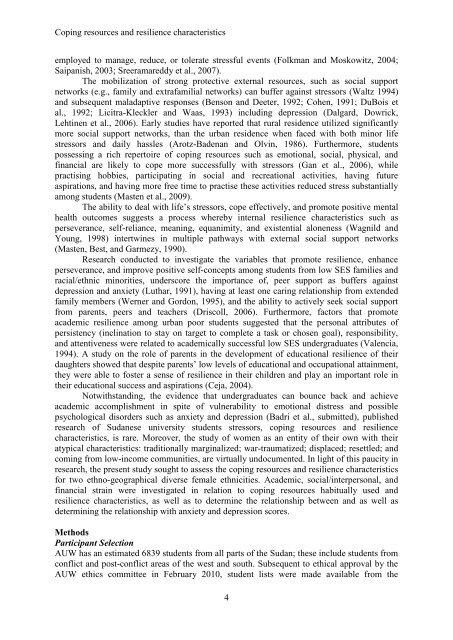Coping resources and resilience characteristics among - The Africa ...
Coping resources and resilience characteristics among - The Africa ...
Coping resources and resilience characteristics among - The Africa ...
Create successful ePaper yourself
Turn your PDF publications into a flip-book with our unique Google optimized e-Paper software.
<strong>Coping</strong> <strong>resources</strong> <strong>and</strong> <strong>resilience</strong> <strong>characteristics</strong><br />
employed to manage, reduce, or tolerate stressful events (Folkman <strong>and</strong> Moskowitz, 2004;<br />
Saipanish, 2003; Sreeramareddy et al., 2007).<br />
<strong>The</strong> mobilization of strong protective external <strong>resources</strong>, such as social support<br />
networks (e.g., family <strong>and</strong> extrafamilial networks) can buffer against stressors (Waltz 1994)<br />
<strong>and</strong> subsequent maladaptive responses (Benson <strong>and</strong> Deeter, 1992; Cohen, 1991; DuBois et<br />
al., 1992; Licitra-Kleckler <strong>and</strong> Waas, 1993) including depression (Dalgard, Dowrick,<br />
Lehtinen et al., 2006). Early studies have reported that rural residence utilized significantly<br />
more social support networks, than the urban residence when faced with both minor life<br />
stressors <strong>and</strong> daily hassles (Arotz-Badenan <strong>and</strong> Olvin, 1986). Furthermore, students<br />
possessing a rich repertoire of coping <strong>resources</strong> such as emotional, social, physical, <strong>and</strong><br />
financial are likely to cope more successfully with stressors (Gan et al., 2006), while<br />
practising hobbies, participating in social <strong>and</strong> recreational activities, having future<br />
aspirations, <strong>and</strong> having more free time to practise these activities reduced stress substantially<br />
<strong>among</strong> students (Masten et al., 2009).<br />
<strong>The</strong> ability to deal with life’s stressors, cope effectively, <strong>and</strong> promote positive mental<br />
health outcomes suggests a process whereby internal <strong>resilience</strong> <strong>characteristics</strong> such as<br />
perseverance, self-reliance, meaning, equanimity, <strong>and</strong> existential aloneness (Wagnild <strong>and</strong><br />
Young, 1998) intertwines in multiple pathways with external social support networks<br />
(Masten, Best, <strong>and</strong> Garmezy, 1990).<br />
Research conducted to investigate the variables that promote <strong>resilience</strong>, enhance<br />
perseverance, <strong>and</strong> improve positive self-concepts <strong>among</strong> students from low SES families <strong>and</strong><br />
racial/ethnic minorities, underscore the importance of, peer support as buffers against<br />
depression <strong>and</strong> anxiety (Luthar, 1991), having at least one caring relationship from extended<br />
family members (Werner <strong>and</strong> Gordon, 1995), <strong>and</strong> the ability to actively seek social support<br />
from parents, peers <strong>and</strong> teachers (Driscoll, 2006). Furthermore, factors that promote<br />
academic <strong>resilience</strong> <strong>among</strong> urban poor students suggested that the personal attributes of<br />
persistency (inclination to stay on target to complete a task or chosen goal), responsibility,<br />
<strong>and</strong> attentiveness were related to academically successful low SES undergraduates (Valencia,<br />
1994). A study on the role of parents in the development of educational <strong>resilience</strong> of their<br />
daughters showed that despite parents’ low levels of educational <strong>and</strong> occupational attainment,<br />
they were able to foster a sense of <strong>resilience</strong> in their children <strong>and</strong> play an important role in<br />
their educational success <strong>and</strong> aspirations (Ceja, 2004).<br />
Notwithst<strong>and</strong>ing, the evidence that undergraduates can bounce back <strong>and</strong> achieve<br />
academic accomplishment in spite of vulnerability to emotional distress <strong>and</strong> possible<br />
psychological disorders such as anxiety <strong>and</strong> depression (Badri et al., submitted), published<br />
research of Sudanese university students stressors, coping <strong>resources</strong> <strong>and</strong> <strong>resilience</strong><br />
<strong>characteristics</strong>, is rare. Moreover, the study of women as an entity of their own with their<br />
atypical <strong>characteristics</strong>: traditionally marginalized; war-traumatized; displaced; resettled; <strong>and</strong><br />
coming from low-income communities, are virtually undocumented. In light of this paucity in<br />
research, the present study sought to assess the coping <strong>resources</strong> <strong>and</strong> <strong>resilience</strong> <strong>characteristics</strong><br />
for two ethno-geographical diverse female ethnicities. Academic, social/interpersonal, <strong>and</strong><br />
financial strain were investigated in relation to coping <strong>resources</strong> habitually used <strong>and</strong><br />
<strong>resilience</strong> <strong>characteristics</strong>, as well as to determine the relationship between <strong>and</strong> as well as<br />
determining the relationship with anxiety <strong>and</strong> depression scores.<br />
Methods<br />
Participant Selection<br />
AUW has an estimated 6839 students from all parts of the Sudan; these include students from<br />
conflict <strong>and</strong> post-conflict areas of the west <strong>and</strong> south. Subsequent to ethical approval by the<br />
AUW ethics committee in February 2010, student lists were made available from the<br />
4


